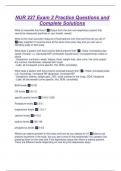NUR 227 Exam 2 Practice Questions and
Complete Solutions
What is insensible fluid loss? ✅Output from the skin and respiratory system that
cannot be measured (particles in your breath, sweat)
What is the most accurate measure of fluid balance over time and how do you do it?
✅Daily weights!! It must be done at the same time every day and you can use a
standing scale or bed scale.
What does a patient with fluid volume deficit present like? ✅- Vitals: increased pulse
(weak, thready 1+), decreased BP (orthostatic hypotension), increased temp unless in
shock
- Symptoms: confusion, weak, fatigue, thirst, weight loss, dark urine, low urine output,
dry mucous membranes, reduced skin turgor
- Labs: all increased! (urine specific, Hct, BUN, osmolality)
What does a patient with fluid volume overload present like? ✅- Vitals: increased pulse
(>3+ bounding), increased RR (dyspnea), increased BP
- Symptoms: edema, weight gain, JVD, moist cracked in the lungs, SOA, headache
- Labs: all decreased! (urine specific, Hct, BUN, osmolality)
BUN levels ✅10-20
CR levels ✅0.5-1.2
specific gravity levels ✅1.010-1.030
Potassium levels ✅3.5-5
magnesium levels ✅1.3-2.1
calcium levels ✅9-10.5
sodium levels ✅135-145
phosphorus levels ✅3-4.5
Where can edema present in the body and how do you assess for it? ✅Edema can
present anywhere in the body, but you see it most in the peripherals! You assess it by
pressing down on the area and if the depression stays then there is edema present.
There are different levels depending on how long the depression stays.
,Where is most of our fluid? ICF or ECF? ✅ICF
How does a patient present clinically if they are euvolemic? How do you know they are
euvolemic? ✅A patient that is euvolemic has nearly the same amount of intake and
output. Considering that it is normal they will present when vital signs and labs are in
range.
How does a patient present clinically if they are hypovolemic? What is your priority
nursing care? ✅- Typically weak, fatigued, weight loss, dec BP
- Priority nursing care: Oral/IV fluids, identifying vulnerable patients, and protect from
injury due to low BP
How does a patient present clinically if they are fluid overloaded? What is your priority
nursing care? ✅- Typically have weight gain, edema, JVD, headache, moist crackles in
lungs
- Priority nursing care: restrict fluids, administer diuretics, identify/treat underlying cause
What clinical assessment data tells you an overloaded patient may have fluid near/in
the lungs? ✅Crackles during auscultation, dyspnea
What is your goal for urine output? What information does "adequate urine production"
tell you about your patient? ✅- 800-2,000 ml per day is goal
- Should be clear/pale yellow, no weird orders, shouldn't hurt, no blood, normal
concentration
- Adequate urine production means that a patient is taking in the proper amount of liquid
and their kidneys and urinary tract are working properly
What is the first step(s) when you notice decreased urine output in your i/o charting?
✅Would assess the patient's intake of fluids as well as figuring out the cause. Is it due
to vomiting, diarrhea, heat-related, any use of diuretics?
What are the priority assessments/body systems affected by sodium imbalance?
✅NEURO, cardiac, respiratory, GI
What are the priority assessments/body systems affected by potassium imbalance?
✅CARDIAC, respiratory, neuro, GI, renal status, neuromuscular
What are the priority assessments/body systems affected by magnesium imbalance?
✅cardiac, respiratory, neuro, GI, renal
What are the priority assessments/body systems affected by phosphorous and calcium
imbalance? ✅cardiac, respiratory, MSK, neuro
, What is your priority nursing care for sodium? ✅- Hypo: intake oral sodium, restrict
fluid, diuretics, if critical hypertonic solutions can be given
- Hyper: force fluids, sodium restriction, hypotonic IV fluid (slowly)
What is your priority nursing care for potassium? ✅- Hypo: PO/IV potassium, K rich
food → AVOID: lasix, thiazides
- Hyper: Kayexalate (promotes GI sodium absorption=potassium excretion), K wasting
drugs (lasix or HCTZ), glucose and regular insulin (pulls K in cell), dialysis
What is your priority nursing care for magnesium? ✅- Hypo: IV Mg sulfate, seizure
precautions
- Hyper: ensure safety, monitor cardiac rhythm and breathing
What is your priority nursing care for phosphate? ✅Hypo: PO/IV phosphate (place on
tele, slowly on central line, and monitor Ca levels)
What is your priority nursing care for calcium? ✅- Hypo: IV Ca (monitor Ca and Phos
closely), PO Ca and vitamin D, Ca rich food
- Hyper: avoid Ca rich food, and hydration!, calcitonin, dialysis
Can you describe how a patient would present clinically with sodium imbalance?
✅Hypo: SALT LOSS
Seizures, Abdominal cramping, Lethargic, Troubling concentration, Loss of urine &
appetite, Orthostatic hypotension, Shallow respirations, Spasms of muscles
Hyper: FRIED
Fever/ Flushed skin, Restless and confusion, Increased fluid retention, Edema,
Decreased urine output/ Dry mouth/skin
Can you describe how a patient would present clinically with potassium imbalance?
✅Hypo: Let's Show How We Can Let Loose
Lethargic, Shallow respirations, Hypotension, Weak muscles, Cardiac dysrhythmias,
Lots of urine, Leg cramps
Hyper: MURDER
Muscle weakness, Urine GONE, Respiratory failure, Decreased heart contractility, Early
signs of muscle twitches/cramps, Rhythm changes (EKG)
Can you describe how a patient would present clinically with magnesium imbalance?
✅Hypo: TWITCHING
Trousseau sign, Weak respirations, Irritability, Torsades de pointes/ Tetany, Cardiac
changes, HTN/ Hyperreflexia, Involuntary movements, Nausea, GI issues (decreased
bowel sounds and mobility)
Hyper: LETHARGIC




